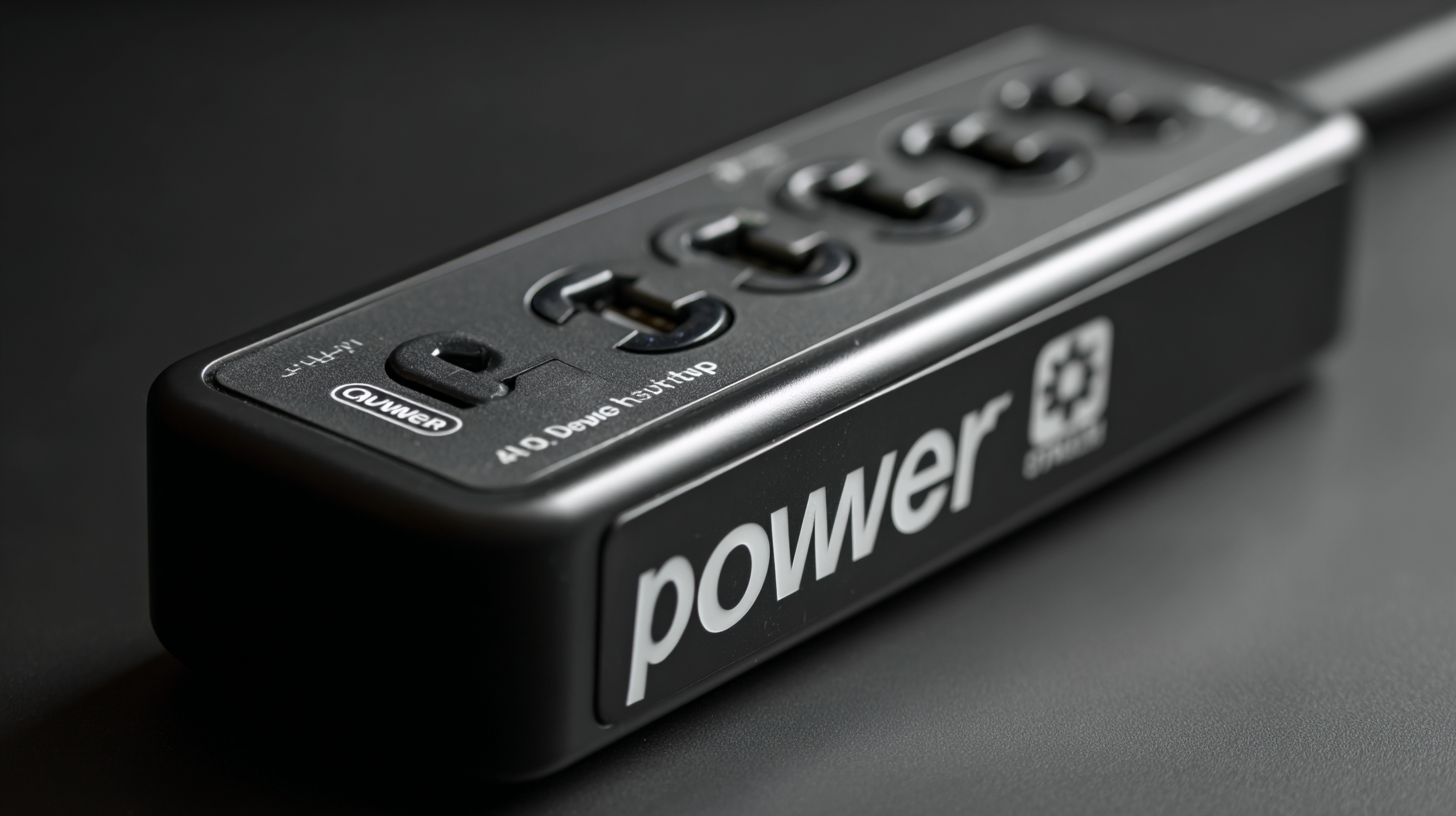Exploring Unique Alternatives to the Best Power Strip for Enhanced Energy Management
In an era where energy efficiency and sustainable practices are increasingly paramount, the exploration of alternatives to traditional power strips has become essential. A recent report by the U.S. Department of Energy indicated that standby power, often referred to as "phantom load," can account for 10% to 20% of residential energy use, largely driven by the common power strip. While power strips provide convenience, they often contribute to energy waste without proper management. Innovative solutions, such as smart power hubs and energy monitoring devices, have emerged, offering consumers optimized energy control and reduced consumption. These alternatives not only mitigate the impact of phantom loads but also align with the growing industry trend towards smarter, more environmentally conscious energy management systems. As we delve deeper into this topic, we'll uncover various unique alternatives to the standard power strip that enhance energy management across different sectors.

Innovative Power Strip Models: Redefining Energy Management Solutions
In an era where energy efficiency is paramount, innovative power strip models are stepping up to redefine energy management solutions. Traditional power strips often lack the smart technology needed to optimize energy usage, which is critical as the U.S. Energy Information Administration reports that residential energy consumption is projected to increase by 4% by 2030. New models are now equipped with features like smart timers, energy monitoring displays, and outlets that can be controlled remotely via apps, allowing users to minimize phantom energy usage—estimated to account for 5-10% of a household's total energy consumption.

Moreover, some advanced power strips utilize artificial intelligence to analyze usage patterns and adjust energy distribution accordingly. A recent study from the Lawrence Berkeley National Laboratory noted that integrating smart power management in homes could lead to energy savings of 10-30%, significantly reducing utility bills. With these innovative designs, consumers can not only enhance their energy management practices but also contribute to a larger goal of energy conservation, making modern power strips an essential tool for both efficiency and sustainability in everyday life.
Smart Power Hub Options for Optimizing Home Energy Efficiency
In today's energy-conscious world, optimizing home energy efficiency is more important than ever. One of the most effective ways to achieve this is through the use of smart power hubs. Unlike traditional power strips, these innovative devices are designed to monitor and manage energy consumption intelligently. With features such as individual outlet control, real-time energy monitoring, and scheduling capabilities, smart power hubs allow homeowners to reduce energy waste and save on utility bills.
Moreover, many smart power hubs integrate seamlessly with home automation systems and voice assistants, enabling users to manage their devices with simple voice commands or through mobile apps. This adds a layer of convenience for busy households, allowing for effortless energy management—whether turning off unused devices or programming them to operate during off-peak hours. Additionally, selecting smart power solutions that offer surge protection and energy tracking can significantly enhance safety and provide valuable insights into overall energy usage patterns, making them a vital component of modern home management.
Comparative Analysis: Traditional Power Strips vs. Alternative Energy Solutions
In today’s energy-conscious world, the conventional power strip has often been seen as the go-to solution for connecting multiple devices. However, a comparative analysis reveals that alternative energy solutions can provide enhanced efficiency and better management of electrical loads. According to the U.S. Department of Energy, traditional power strips can result in a waste of up to 10% of the energy consumed by electronic devices due to phantom loads. This highlights the need for smarter options that minimize energy consumption.
Smart power strips and energy management systems are emerging as viable alternatives, equipped with features like scheduling, energy monitoring, and automatic shutoff capabilities. A report from MarketsandMarkets suggests that the smart power strip market is projected to grow from $1.3 billion in 2020 to $3.1 billion by 2025, reflecting a significant shift toward energy management solutions that not only reduce waste but also empower users to track their consumption more effectively. These advanced solutions not only prevent energy waste but also promote sustainability, making them a compelling choice for both residential and commercial use. The ongoing evolution of energy management technology is reshaping how individuals and businesses approach their energy needs.

Eco-Friendly Power Solutions: Reducing Energy Waste with Modern Designs
As the world becomes more conscious of environmental issues, eco-friendly power solutions have gained importance in our daily lives. Modern power strip designs now emphasize energy efficiency, reducing waste while delivering optimal performance. Innovative features, such as built-in timers and smart technology, allow users to schedule and monitor energy consumption, ensuring that power is not squandered on devices that are left plugged in but unused. This approach not only lowers electricity bills but also contributes to a more sustainable future.
Incorporating energy-saving technologies, such as surge protection and energy monitoring, sets these eco-friendly power strips apart from traditional models. Some designs even utilize recyclable materials, minimizing their ecological footprint from production to disposal. By selecting power strips that prioritize reduced energy waste, consumers not only enhance their energy management practices but also make a positive impact on the environment. These modern solutions reflect a growing trend toward sustainability, allowing consumers to power their devices responsibly while supporting a greener planet.
Exploring Unique Alternatives to the Best Power Strip for Enhanced Energy Management
| Product Type |
Energy Saving (% per year) |
Features |
Eco-Friendly Materials |
Average Price ($) |
| Smart Power Strip |
30 |
Remote Control, Timer, USB Ports |
Recycled Plastics |
25 |
| Surge Protector |
20 |
Surge Protection, Indicator Lights |
Eco-Friendly Housing |
30 |
| Power Monitor |
40 |
Real-time Monitoring, App Integration |
Biodegradable Components |
45 |
| Eco-Friendly Extension Cord |
15 |
Flexible Length, Multiple Outlets |
Organic Materials |
20 |
Future Trends in Power Distribution: Exploring Wireless and Automated Systems
As energy consumption continues to rise, the quest for efficient power distribution has led innovators to explore wireless and automated systems. These technologies promise to revolutionize the way we manage energy in our homes and workplaces. Wireless power systems eliminate unsightly cords and clutter, allowing for a cleaner and more flexible setup. By utilizing technologies like magnetic resonance or capacitive coupling, devices can be charged without direct contact, enhancing convenience and usability.
Automated energy management systems are also gaining traction, offering a way to optimize energy usage and identify waste. Smart plugs and hubs integrate with home automation systems, allowing users to schedule or remotely control their devices. These systems not only provide real-time monitoring of energy consumption but also enable users to participate in demand response programs, promoting energy efficiency and potentially lowering costs. As we embrace these future trends in power distribution, we pave the way for a more sustainable and user-friendly approach to managing our energy needs.
Exploring Unique Alternatives to the Best Power Strip for Enhanced Energy Management
This chart illustrates the energy distribution among different power management systems, showcasing the effectiveness of wireless and automated systems compared to traditional power strips. The data reflects the average energy efficiency ratings based on recent studies.





